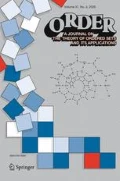Abstract
We survey the problem of counting the number of linear extensions of a partially ordered set. We show that this problem is #P-complete, settling a long-standing open question. This result is contrasted with recent work giving randomized polynomial-time algorithms for estimating the number of linear extensions.
One consequence of our main result is that computing the volume of a rational polyhedron is strongly #P-hard. We also show that the closely related problems of determining the average height of an element x of a give poset, and of determining the probability that x lies below y in a random linear extension, are #P-complete.
Similar content being viewed by others
References
D. Applegate and R. Kannan (1991) Sampling and integration of near log-concave functions, Proc. 23rd ACM Symposium on the Theory of Computing, 156–163.
M. D.Atkinson (1985) Partial orders and comparison problems, Congressus Numerantium 47, 77–88.
M. D.Atkinson and H. W.Chang (1985) Extensions of partial orders of bounded width, Congressus Numerantium 52, 21–35.
M. D.Atkinson and H. W.Chang (1987) Computing the number of mergings with constraints, Information Processing Letters 24, 289–292.
G. Brightwell and P. Winkler (1991) Counting linear extensions is #P-complete, Proc. 23rd ACM Symposium on the Theory of Computing, 175–181.
A. Z. Broder (1986) How hard is it to marry at random? (On the approximation of the permanent), Proc. 18th ACM Symposium on the Theory of Computing, 50–58.
M. Dyer and A. Frieze, On the complexity of computing the volume of a polyhedron, SIAM J. Computing, to appear.
M. Dyer and A. Frieze, Computing the volume of convex bodies: a case where randomness provably helps, preprint.
M. Dyer, A. Frieze, and R. Kannan (1989) A randomly polynomial time algorithm for estimating volumes of convex bodies, Proc 21st ACM Symposium on the Theory of Computing, 375–381.
J. Feigenbaum, private communication.
P. C.Fishburn and W. V.Gehrlein (1975) A comparative analysis of methods for constructing weak orders from partial orders. J. Math. Sociology 4, 93–102.
M.Habib and R. H.Mohring (1987) On some complexity properties of N-free posets and posets with bounded decomposition diameter, Discrete Math. 63, 157–182.
G. H. Hardy and E. M. Wright (1960) An Introduction to the Theory of Numbers, 4th Ed., Oxford University Press.
M. Jerrum and A. Sinclair (1988) Conductance and the rapid mixing property for Markov chains: the approximation of the permanent resolved, Proceedings of the 20th ACM Symposium on Theory of Computing, 235–244.
J.Kahn and M.Saks (1984) Balancing poset extensions, Order 1(2), 113–126.
A.Karzanov and L.Khachiyan (1991) On the conductance of order Markov chains, Order 8 (1), 7–15.
L. Khachiyan, Complexity of polytope volume computation, Recent Progress in Discrete Computational Geometry, J. Pach ed., Springer-Verlag, to appear.
H. Kierstead and W. T. Trotter, The number of depth-first searches of an ordered set, submitted.
N.Linial (1986) Hard enumeration problems in geometry and combinatorics, SIAM J. Alg. Disc. Meth. 7(2), 331–335.
L.Lovász (1986) An Algorithmic Theory of Numbers, Graphs and Convexity, SIAM, Philadelphia.
L. Lovász and M. Simonovits (1990) The mixing rate of Markov chains, an isoperimetric inequality, and computing the volume, Proc. 31st IEEE Symposium on Foundations of Computer Science, 346–355.
P.Matthews (1991) Generating a random linear extension of a partial order, Annals of Probability, 19, 1367–1392.
S.Provan and M. O.Ball (1983) On the complexity of counting cuts and of computing the probability that a graph is connected, SIAM J. Computing 12, 777–788.
A.Sinclair and M.Jerrum (1989) Approximate counting, generation and rapidly mixing Markov chains, Information and Computation 82, 93–133.
G. Steiner, Polynomial algorithms to count linear extensions in certain posets, Congressus Numerantium, to appear.
G. Steiner, On counting constrained depth-first linear extensions of ordered sets, preprint.
S. Toda (1989) On the computational power of PP and +P, Proc. 30th IEEE Symposium on Foundations of Computer Science, 514–519.
L. G.Valiant (1979) The complexity of computing the permanent, Theoret. Comput. Sci. 8, 189–201.
L. G.Valiant (1979) The complexity of enumeration and reliability problems, SIAM J. Comput. 8, 410–421.
P.Winkler (1982) Average height in a partially orderd set, Discrete Math. 39, 337–341.
Author information
Authors and Affiliations
Additional information
Communicated by I. Rival
Research carried out while this author was visiting Bellcore under the auspices of DIMACS.
Rights and permissions
About this article
Cite this article
Brightwell, G., Winkler, P. Counting linear extensions. Order 8, 225–242 (1991). https://doi.org/10.1007/BF00383444
Received:
Accepted:
Issue Date:
DOI: https://doi.org/10.1007/BF00383444



